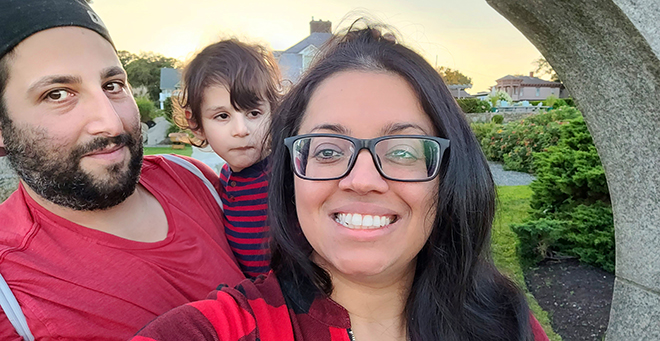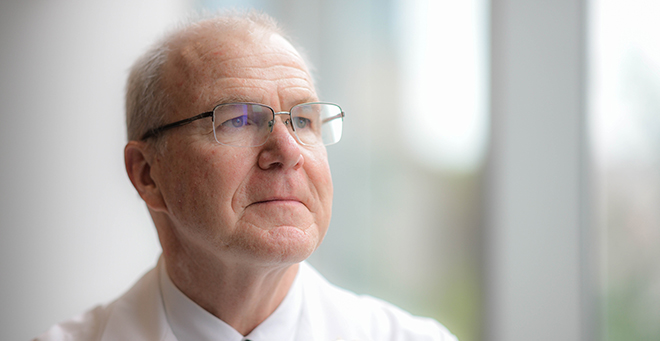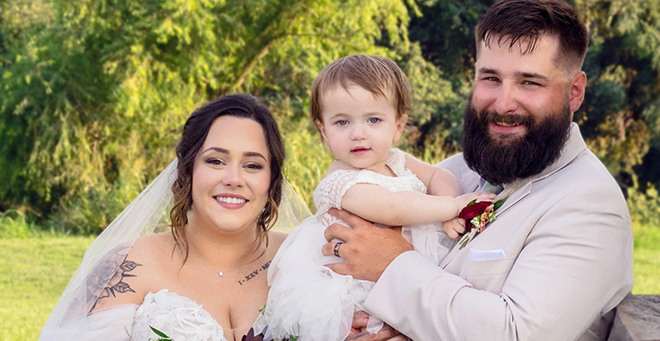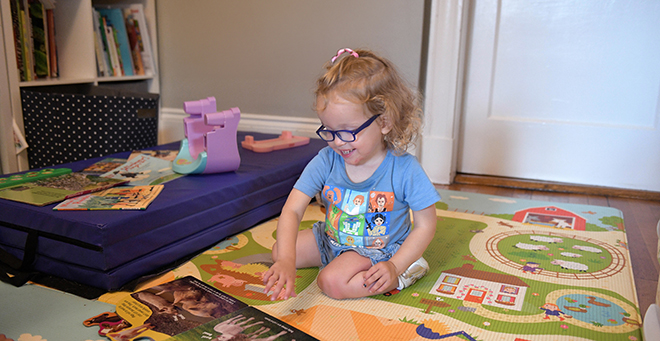‘They are the heroes’
Families of children with genetic disorders inspire gene therapy research; new translational institute streamlines ‘bench to bedside’
By Susan E.W. Spencer

(photo: Faith Ninivaggi)
Three-year-old Noa Greenwood, an inquisitive toddler with a cherubic smile, a taste for pizza and a flair for fashionable footwear, is living inspiration for the promise of gene therapy. Diagnosed at 11 months with Canavan disease, a fatal genetic disorder that attacks the central nervous system, the Boston tot became one of the first to receive an investigational therapy developed at UMass Chan Medical School.
More than a year later, Noa’s parents say she’s interacting with family, feeding herself and walking with a walker.
“It’s dramatic changes, all the things that you’d say—and they’re all true. But this is not the child that was on the trajectory that she was on,” said Noa’s father, Lee Greenwood.
Adalynn Murray, age 1 ½, came to UMass Chan with her parents from Hannibal, Missouri, in February to participate in a gene therapy trial for Tay-Sachs disease, a rare genetic disorder that destroys nerve cells in the brain and spinal cord. Ten months after her treatment, Adalynn also shows promising signs.
“She has been getting stronger every day,” said her mother, Megan Murray. “She is able to eat much thicker foods; she’s grown with her skills; she says, ‘mama’ and ‘no’; she practices standing in physical therapy and she’s able to stand up on her own for a few seconds.”

Riaan DiGeorge, a 4-year-old New York City preschooler, is helping drive the push for UMass Chan researchers in the new Translational Institute for Molecular Therapeutics to develop a treatment for Cockayne syndrome, a neurodegenerative disease. His parents, Jo Kaur and Richard DiGeorge, founded the nonprofit Riaan Research Initiative, and entered into an agreement with UMass Chan in 2021 to support research into the fatal genetic disorder.
Since then, UMass Chan researchers have announced a proof-of-concept milestone showing the therapeutic effectiveness of an adeno-associated virus (AAV) vector for gene replacement in a mouse model of Cockayne syndrome. An application to the Food and Drug Administration for investigational new drug (IND) status, which would allow clinical trials in humans to begin, is being prepared.
“We’re at a place we never thought we’d be,” said Kaur. “It feels like we’ve already climbed Mount Everest and then some, but we know we still have an incredibly long way to go.”
UMass Chan has become a powerhouse of gene therapy research over the past two decades. Collaboration among researchers, clinical faculty and brave patient families willing to be part of the journey is advancing medical science closer to a cure.
“The passion of some of our investigators here has really driven these efforts forward and allowed partnerships between those who are working on platform technology to deliver gene therapy and those who are working on the diseases themselves,” said Terence R. Flotte, MD, the Celia and Isaac Haidak Professor, executive deputy chancellor, provost, dean of the T.H. Chan School of Medicine and professor of pediatrics.
Especially for rare diseases, he said, “It’s almost always the families who are really pushing the envelope. Some are fundraising to support research for their condition and also helping to find the scientist experts and getting them together to address their condition.”
Pioneering research advances at UMass Chan
Dr. Flotte, an internationally known pioneer in gene therapy research, arrived at UMass Chan in 2007, more than a decade after serving as the principal investigator who led the team at Johns Hopkins in the first successful gene transfer with an AAV vector in animals and the first ever human trial of an AAV.
UMass Chan’s main focus then was on RNA- based therapeutics, coming shortly after the 2006 Nobel Prize in Medicine or Physiology was awarded to Craig C. Mello, PhD, the Blais University Chair in Molecular Medicine and distinguished professor of molecular medicine, for his co-discovery of RNA interference.
The science recognized by that Nobel Prize spurred, in the years that followed, the establishment of the Horae Gene Therapy Center and the RNA Therapeutics Institute, which have led to advances in gene therapy platforms and potential treatments for a host of rare diseases including Tay-Sachs, Canavan and amyotrophic lateral sclerosis.

(photo: Faith Ninivaggi)
Guangping Gao, PhD, the Penelope Booth Rockwell Professor in Biomedical Research, professor of microbiology & physiological systems, director of the Horae Gene Therapy Center and co-director of the Li Weibo Institute for Rare Disease Research, who was recruited to UMass Chan by Flotte, has been a driving force behind gene therapy for patients with rare diseases. He discovered the gene and mutations responsible for Canavan disease in 1993 and has spent his career pursuing a treatment.
“Everything is about patients and families. They are the heroes,” said Dr. Gao. “What we’re trying to do is to make some difference in their lives.”
Flotte said, “It’s a hopeful time, but also a time where we’re somewhat on the precipice, because the clock is ticking. The child may have a condition that continues to progress as we’re working on the research. That makes it all the more crucial that we accelerate translating knowledge about what the gene is into some form of therapy.”
UMass Chan’s Translational Institute for Molecular Therapeutics was launched in 2022 to address just this type of need. Families who have a child with a rare disease have few options because not much may be known about the genetic mutations associated with the disease; and because it is rare, funding opportunities for developing treatments are limited.
“The institute came about with the recognition that we have fantastic basic research, but then we don’t have an outlet for it, and investigators had to learn individually the pathway from the bench discovery to the clinic,” said Miguel Sena- Esteves, PhD, associate professor of neurology and director of the Translational Institute. “We want to establish the necessary infrastructure to support the efficient transition from discovery to a first-in-human clinical trial.”

(photo: Faith Ninivaggi)
“It’s almost always the families who are really pushing the envelope. Some are fundraising to support research for their condition and also helping to find the scientist experts and getting them together to address their condition.”
Inspired by patients
When Noa Greenwood was born in August 2020, during the height of the global COVID-19 pandemic, Canavan disease was not among her parents’ worries. In fact, they had never heard of it.
Still, the Greenwoods knew something was going on with Noa from nearly the beginning. She would cry inconsolably every waking moment.
“By about eight weeks, we were concerned that there was something wrong with her vision: She wouldn’t follow us or respond to us,” said her mother, Lori Greenwood. “That led to concerns about weight gain, missing milestones, acid reflux—it was just issue after issue. We really had a hard time connecting all the dots to figure out what’s going on.”
The Greenwoods were told Noa would get over it. It was colic. Or fussiness. Finally, at 11 months, they were able to see a neurologist in Boston and get an MRI.
“When we got that diagnosis, over Zoom, it was heartbreaking,” Lori Greenwood continued. “We’re Googling Canavan disease and it was like, oh my God, this connects all those dots.”
But instead of telling the Greenwoods, “Sorry, there’s nothing to be done,” Noa’s pediatric neurologist mentioned there was a clinical trial on the horizon that could make a difference.
The same day Noa was diagnosed with Canavan disease, the CANaspire Phase I-II open-label clinical trial sponsored by Aspa Therapeutics, a BridgeBio company, opened on the website ClinicalTrials.gov. The trial investigates the gene therapy developed by researchers at UMass Chan led by Gao and Dominic J. Gessler, MD, PhD’20, assistant professor of neurological surgery. Mass General Hospital neurologist Florian Eichler, MD, is principal investigator on the trial.
“We were, like, the first family to be given this idea that there was something you could do,” Lori Greenwood said. “There’s a trial, there’s a doctor, it’s all here. We were the first to be given that hope. And that’s such a powerful thing to have, a glimmer of hope.”
Noa received a dose of gene therapy BBP- 812 in June 2022, becoming the third child to participate in the CANaspire trial.
The Greenwoods connected with Gao in November 2022 when Gao was honored for his work by the National Tay-Sachs & Allied Diseases Association at its “Imagine & Believe” gathering in Boston. The family stayed in touch, and in April 2023 they brought Noa to the Medical School to meet the research team behind the gene therapy, as a special “thank you.”
After the visit from the Greenwoods, Gao said, “What Noa is doing is just what my grandchildren would do. Canavan research is part of my life, and to see gene therapy make a difference, it’s just so satisfying.”
Now, life in the Greenwood household, which also includes Noa’s 7-year-old sister and best playmate, Max, and rescue dog, Gracie, is full of family energy. The girls play; they go to school or day care while their parents work. And their parents laugh, cry and high-five each other when Noa and Max squabble, something they never imagined Noa would be able to do.
Lee Greenwood said, “Whatever the long-term outcomes are, we have no idea, we understand that that’s what a trial is all about. She’s the guinea pig, but just to have this time to have this beautiful child. We can’t express how incredibly fortunate we feel. This is who you’re fighting for.”
Adalynn Murray, diagnosed with Tay-Sachs disease, is also progressing after receiving gene therapy in February as part of a clinical trial led by Flotte at UMass Chan and Dr. Eichler at Mass General.
Her mother recalled, “The day she was born, I noticed that her eyes would shake back and forth. I mentioned that to the doctor, and they told me to give it three months and it will go away.”
When the shaking got worse, Adalynn saw an ophthalmologist, who diagnosed her with nystagmus, a condition of involuntary eye movements.
“And that is when they found the red cherry spot in the back of her eye, which led to seeing a neurologist and led to her diagnosis,” said Megan Murray. “We caught it before most people do.” The lab that notified Megan Murray of the test results told her that Adalynn had a life expectancy of two to three years. But the neurologist who had made the diagnosis knew about a clinical trial at UMass Chan.

When the call finally came several months later that Adalynn was eligible, Megan Murray and her then-fiancé, Hunter Murray, got their first real sense of hope. Their employers—she is a dental assistant and he works in construction— were “really great bosses who held our jobs” while the family traveled from the Midwest to Massachusetts for treatment, and while Megan Murray stayed home afterward with Adalynn, who is immunosuppressed.
Meeting Flotte for the first time was “very emotional” for the Murrays. “Dr. Flotte and the research team ended up being like family, almost. It was such a comfort to be there,” Megan Murray said.
While in Massachusetts, Adalynn had neurosurgery for gene therapy and then had appointments almost daily, bouncing back and forth between Worcester and Boston for tests, consultations and rehabilitation therapy.
Megan Murray’s life now is hopeful and busy. She’s learned to become an advocate for her child, and when her local health care providers have questions about Adalynn’s care, “Dr. Flotte is quick to say, ‘Tell them to give me a call,’” she said.
She believes families such as hers play an important role in advancing gene therapy.
“I think the future is dependent on the families that are willing to do clinical trials because every kid is different,” she said. “Adalynn was the only kid that hadn’t had symptoms yet, so that was new for them. I just think it feels good to be able to help out and potentially save another kid.”
“We have to know that we tried, and we have to keep trying,” said Jo Kaur, whose son, Riaan, has an ultrarare genetic condition, Cockayne syndrome. “That’s what we will do until hopefully we can get a treatment for this disease.”
The journey to find a treatment for Riaan began shortly after he was diagnosed, at around 15 months. Kaur, a civil rights attorney, and DiGeorge, a special education teacher, were blindsided by the news and didn’t know where to turn. So, they posted Riaan’s story on Twitter (now X).
“A number of people reached out and said, there are things that you can do,” said Kaur. “And that’s when we became connected with the rare disease warrior community.”
Through those initial contacts, Kaur and DiGeorge heard from a specialist at Harvard and a researcher at the National Institutes of Health, who put them in touch with Flotte.
Kaur said, “I emailed Dr. Flotte and literally a week later we had a Zoom and sorted it out from there.”
Kaur and DiGeorge founded a nonprofit foundation to raise money to support research on Cockayne syndrome, a funding avenue that Flotte said is a major resource for many rare diseases that don’t attract biopharma investment or grants because of the risks and small potential market.
“The part of this diagnosis that’s so challenging is the unknowns,” said Kaur. “There are so few with the disease in the world. It’s like being lost at sea, you’re really on an island by yourself and having to learn more about it and connect with scientists and researchers that want to tackle it and treat it. That’s how we cope. And it’s also how we keep going despite having this impossible diagnosis.”
Flotte brought in Dr. Sena-Esteves and fellow researcher Ana Rita Batista, PhD, instructor in neurology, to lead the research into a Cockayne syndrome gene replacement therapy. Their work through the Translational Institute for Molecular Therapeutics reached the important proof-of- concept milestone testing an AAV vector in mice and the team is working toward submitting the IND application to the FDA to proceed with human trials.
In a little more than two years, the Riaan Research Initiative has raised almost $2.9 million, a process Kaur called, “a journey of miracles.” Riaan, a bright, energetic child who loves playing soccer using his gait trainer and listening to Sesame Street songs, provides a personal face to the scientists as they advance their work. But it’s a race against the clock to stave off declines.
Riaan’s family has monthly calls with the research team and participates actively as partners. Kaur said being involved every step of the way offers benefits besides commitment and fundraising.
“We don’t have the barriers that scientists might face in terms of collaborating with one another because they work at different institutions,” she said. “We’re sort of like free agents. We just email or phone other scientists in different countries and connect to people.”
Kaur pointed to a connection the family made with researchers in Switzerland, who had embryos of the mice that were needed and were able to get those embryos to UMass Chan, which helped expand and build their colony.
“It’s incredible because we had no idea what to expect when we first got the diagnosis,” said DiGeorge. “And now there is that array of people that want to help and you know, we are going to get this done.”
Dr. Batista, who leads the Cockayne syndrome research, came to UMass Chan from Portugal in 2014 with a background in neurobiology and a research interest in studying a rare protein disorder. She wasn’t familiar with Cockayne syndrome until Flotte and Sena-Esteves contacted her about the project. Working with families has been invaluable to her.
“There are things about disease characteristics that we learn from families. It’s huge, it’s a resource that you can’t have anywhere else,” she said.
Batista and her team, like other gene therapy scientists at UMass Chan, never stop to question why they relentlessly pursue this path.
“There’s a kid on the other end and so I don’t care about the disease, if it’s brain, muscle or bones,” said Batista. “There’s a kid on the other end who needs help.” ■
